
Flemish Brabant is a province of Flanders, one of the three regions of Belgium. It borders on the Belgian provinces of Antwerp, Limburg, Liège, Walloon Brabant, Hainaut and East Flanders. Flemish Brabant also surrounds the Brussels-Capital Region. Its capital is Leuven. It has an area of 2,118 km2 (818 sq mi) which is divided into two administrative districts containing 65 municipalities. As of January 2019, Flemish Brabant has a population of 1,146,175.
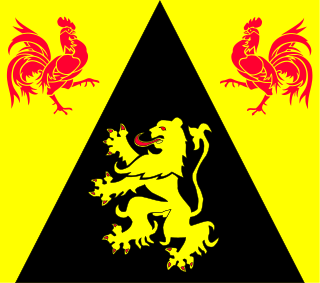
Walloon Brabant is a province located in Belgium's French-speaking region of Wallonia. It borders on the province of Flemish Brabant and the provinces of Liège, Namur and Hainaut. Walloon Brabant's capital- and largest city is Wavre.

Belgium is a federal state comprising three communities and three regions that are based on four language areas. For each of these subdivision types, the subdivisions together make up the entire country; in other words, the types overlap.
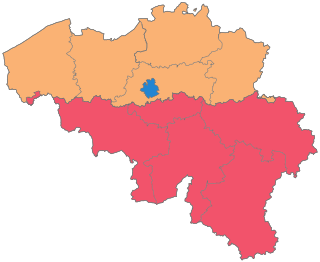
The Kingdom of Belgium is divided into three regions. Two of these regions, Flanders and Wallonia, are each subdivided into five provinces. The third region, Brussels, does not belong to any province and nor is it subdivided into provinces. Instead, it has amalgamated both regional and provincial functions into a single "Capital Region" administration.
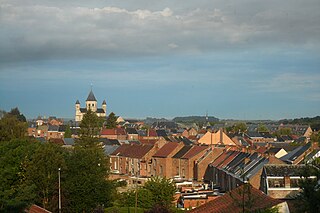
Nivelles is a city and municipality of Wallonia located in the Belgian province of Walloon Brabant. The Nivelles municipality includes the former municipalities of Baulers, Bornival, Thines, and Monstreux.
Brussels, officially the Brussels-Capital Region, is a region of Belgium which includes the City of Brussels which is the capital of Belgium.

Villers Abbey is an ancient Cistercian abbey located in the town of Villers-la-Ville, in the Walloon Brabant province of Wallonia (Belgium), one piece of the Wallonia's Major Heritage. Founded in 1146, the abbey was abandoned in 1796. Most of the site has since fallen into ruins.

The area within Belgium known as Brussels-Halle-Vilvoorde encompasses the bilingual—French and Dutch—Brussels-Capital Region, which coincides with the arrondissement of Brussels-Capital and the surrounding Dutch-speaking area of Halle-Vilvoorde, which in turn coincides with the arrondissement of Halle-Vilvoorde. Halle-Vilvoorde contains several municipalities with language facilities, i.e. municipalities where French-speaking people form a considerable part of the population and therefore have special language rights. This area forms the judicial arrondissement of Brussels, which is the location of a tribunal of first instance, enterprise tribunal and a labour tribunal. It was reformed in July 2012, as part of the sixth Belgian state reform.

Dyle was a department of the French First Republic and French First Empire in present-day Belgium. It was named after the river Dyle (Dijle), which flows through the department. Its territory corresponded more or less with that of the Belgian province of Brabant, now divided into Walloon Brabant, Flemish Brabant and the Brussels-Capital Region. It was created on 1 October 1795, when the Austrian Netherlands and the Prince-Bishopric of Liège were officially annexed by the French Republic. Before the annexation, its territory was partly in the Duchy of Brabant, partly in the County of Hainaut, and partly in some smaller territories.
Lothier refers to the territory within the Duchy of Lower Lotharingia, governed by the dukes of Brabant and their successors after 1190 until the end of the Ancien Régime in 1796.
Arrondissements of Belgium are subdivisions below the provinces of Belgium. There are administrative, judicial and electoral arrondissements. These may or may not relate to identical geographical areas.

The Duchy of Brabant was a State of the Holy Roman Empire established in 1183. It developed from the Landgraviate of Brabant and formed the heart of the historic Low Countries, part of the Burgundian Netherlands from 1430 and of the Habsburg Netherlands from 1482, until it was partitioned after the Dutch revolt.

The Province of Brabant was a province in Belgium from 1830 to 1995. It was created in 1815 as South Brabant, part of the United Kingdom of the Netherlands. In 1995, it was split into the Dutch-speaking Flemish Brabant, the French-speaking Walloon Brabant and the bilingual Brussels-Capital Region.

Luttre is a village of Wallonia and a district of the municipality of Pont-à-Celles, located in the province of Hainaut, Belgium, about 15 km north of Charleroi and 50 km south of Brussels along the Charleroi-Brussels Canal, railway line and motorway. Its name means crystal clear water.
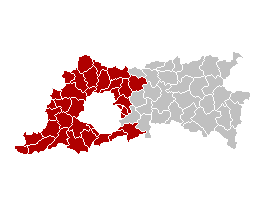
The Halle-Vilvoorde Arrondissement is one of the two administrative arrondissements in the Belgian province of Flemish Brabant. It almost completely surrounds the Brussels-Capital Region and lies to the west of the other arrondissement in the province, the Leuven Arrondissement. Unlike the Arrondissement of Leuven, it is not a judicial arrondissement; however since the sixth Belgian state reform in 2012–14, it has its own public prosecutor's service.

The Arrondissement of Brussels-Capital is the only administrative arrondissement in the Brussels Capital Region in Belgium. Because it is the only administrative arrondissement in the Brussels Region, its territory coincides with that of the latter.
The Arrondissement of Brussels-Periphery was an administrative arrondissement in the Belgian Province of Brabant. It existed from 1963 to 1971 and comprised the six municipalities in the Brussels periphery with language facilities.

Legislative elections were held in Belgium in June and July 1884, for partial Chamber and full Senate elections respectively. Voter turnout was 79.1% in the Chamber of Representatives elections, although only 69,276 people were eligible to vote.
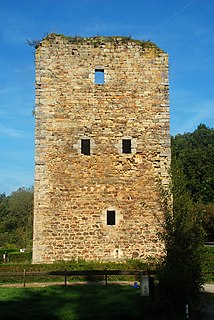
Alvaux Tower, also known as Tour d'Alvaux or Alvau or also called Saracen tower, is a plain residential tower of the late 12th century located in Nil-Saint-Vincent-Saint-Martin, a village in the Belgian town of Walhain, the province of Walloon Brabant.
François le Vasseur, Lord of Moriensart and Over-Heembeeke+ Brussels, 16/3/1603 was a politician of the Southern Netherlands.














